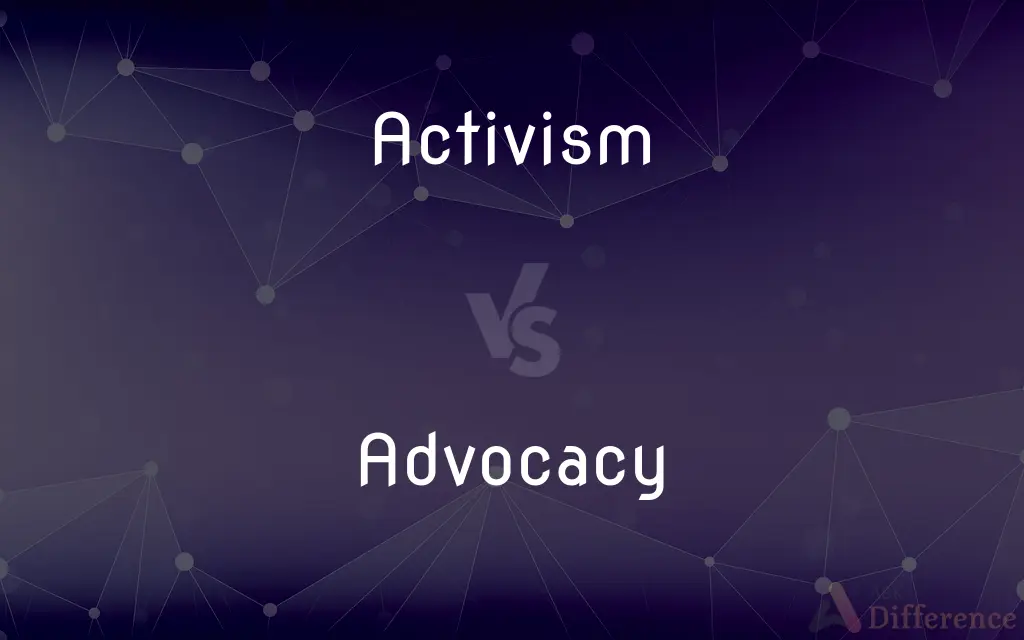Activism vs. Advocacy — What's the Difference?
Edited by Tayyaba Rehman — By Urooj Arif — Updated on March 16, 2024
Activism involves direct action to effect social or political change, while advocacy focuses on influencing decisions within political, economic, and social systems.

Difference Between Activism and Advocacy
Table of Contents
ADVERTISEMENT
Key Differences
Activism is characterized by its focus on direct action, such as protests and demonstrations, aimed at bringing about social or political change. Advocacy, on the other hand, involves working within existing structures to influence policies and decisions. While activists might organize a rally, advocates would likely engage in lobbying or dialogue with policymakers.
Activists often engage in more visible and sometimes confrontational actions to raise awareness and prompt change. They might use tactics like sit-ins, marches, or strikes to draw public attention. Whereas advocates tend to employ more measured approaches, such as research, public speaking, and networking, to sway opinion and policy in a less confrontational manner.
One key distinction is the immediacy and intensity of activism, which seeks to create urgent change through direct engagement. Advocacy, conversely, often plays a longer game, working persistently to shape opinions, laws, and policies over time.
Activism can sometimes operate outside of established channels, challenging norms and institutions directly to enact change. Advocacy typically works within these channels, aiming to transform or influence them from the inside through dialogue and persuasion.
While both activism and advocacy are crucial for societal change, they differ in their strategies and tactics. Activism pushes from the outside, often catalyzing rapid shifts, while advocacy nudges from within, aiming for sustained transformation.
ADVERTISEMENT
Comparison Chart
Focus
Direct action for change
Influence decisions within systems
Tactics
Protests, demonstrations
Lobbying, dialogue
Approach
Often confrontational
Generally measured
Strategy
Immediate change
Long-term influence
Operation
Sometimes outside established channels
Typically within established channels
Compare with Definitions
Activism
Involves engaging in activities like protests to instigate change.
Activists organized a march to demand environmental action.
Advocacy
Focuses on influencing policy through dialogue and persuasion.
Advocates met with legislators to discuss education reform.
Activism
Aims to raise awareness about issues through visible actions.
Activists created a public art installation to highlight social injustice.
Advocacy
Builds networks and alliances to strengthen influence.
Advocates formed a coalition to support healthcare access.
Activism
May use confrontational methods to achieve goals.
Activists staged a sit-in at a government building to protest policies.
Advocacy
Utilizes research to inform and support advocacy efforts.
Advocates published a report on housing inequality to influence policy.
Activism
Often involves mobilizing communities to take collective action.
Activists rallied the community to support local sustainability initiatives.
Advocacy
May involve legal action or support to change laws.
Advocates filed a lawsuit to challenge discriminatory legislation.
Activism
Seeks to create immediate impact and visibility.
Activists blocked roads to draw attention to climate change.
Advocacy
Engages in public speaking and campaigns to sway opinion.
Advocates launched a campaign to raise awareness about mental health.
Activism
Activism consists of efforts to promote, impede, direct, or intervene in social, political, economic, legal, or environmental reform with the desire to make changes in society toward a perceived greater good. Forms of activism range from mandate building in the community (including writing letters to newspapers), petitioning elected officials, running or contributing to a political campaign, preferential patronage (or boycott) of businesses, and demonstrative forms of activism like rallies, street marches, strikes, sit-ins, or hunger strikes.
Advocacy
Advocacy is an activity by an individual or group that aims to influence decisions within political, economic, and social institutions. Advocacy includes activities and publications to influence public policy, laws and budgets by using facts, their relationships, the media, and messaging to educate government officials and the public.
Activism
The use of direct, often confrontational action, such as a demonstration or strike, in opposition to or support of a cause.
Advocacy
The act of pleading or arguing in favor of something, such as a cause, idea, or policy; active support.
Activism
The practice of using action to achieve a result, such as political demonstration or a strike in support of or in opposition to an issue.
Advocacy
The profession of an advocate
Activism
A policy of taking direct and militant action to achieve a political or social goal.
Advocacy
The act of arguing in favour of, or supporting someone or something
Activism
A policy of taking direct and militant action to achieve a political or social goal
Advocacy
The practice of supporting someone to make their voice heard
Advocacy
The act of pleading for or supporting; work of advocating; intercession.
Advocacy
Active support; especially the act of pleading or arguing for something
Common Curiosities
Is one more effective than the other?
Effectiveness depends on the context and goals; both can be powerful in different scenarios.
Do activists always use confrontational methods?
Not always, but activism is more likely to include direct and sometimes confrontational actions.
Can advocacy involve legal actions?
Yes, legal advocacy is a common tactic, using the legal system to effect change.
Is advocacy only related to politics?
No, advocacy can relate to a wide range of issues, including social, environmental, and economic matters.
Can activism and advocacy overlap?
Yes, they often intersect, with advocacy campaigns incorporating activist tactics and vice versa.
Can someone be both an activist and an advocate?
Absolutely, many people combine both approaches depending on the situation and objectives.
Can activism lead to policy changes?
Yes, activism can pressure policymakers to enact changes, though it often works outside traditional policy-making channels.
Can businesses engage in advocacy?
Yes, businesses often engage in advocacy to influence policies that affect their interests.
Are there risks associated with activism?
Activism, especially when confrontational, can carry risks such as legal repercussions or public backlash.
How do advocates influence policy?
Advocates influence policy through research, lobbying, building networks, and public campaigns.
Can activism be part of social movements?
Yes, activism is often a driving force in social movements seeking widespread change.
Can activism be peaceful?
Yes, many forms of activism, such as peaceful protests and art installations, are non-confrontational.
Is advocacy always within legal and institutional frameworks?
Generally, yes, advocacy works within systems to influence change, though it can sometimes challenge existing norms.
How do people choose between activism and advocacy?
The choice often depends on personal preference, the issue at hand, and the desired outcome, with some preferring direct action and others strategic influence.
Do advocates need to be experts?
While not always experts, advocates often need a good understanding of their issue to effectively influence opinions and policies.
Share Your Discovery

Previous Comparison
Scrumble vs. Scumble
Next Comparison
Traditional vs. ClassicAuthor Spotlight
Written by
Urooj ArifUrooj is a skilled content writer at Ask Difference, known for her exceptional ability to simplify complex topics into engaging and informative content. With a passion for research and a flair for clear, concise writing, she consistently delivers articles that resonate with our diverse audience.
Edited by
Tayyaba RehmanTayyaba Rehman is a distinguished writer, currently serving as a primary contributor to askdifference.com. As a researcher in semantics and etymology, Tayyaba's passion for the complexity of languages and their distinctions has found a perfect home on the platform. Tayyaba delves into the intricacies of language, distinguishing between commonly confused words and phrases, thereby providing clarity for readers worldwide.















































